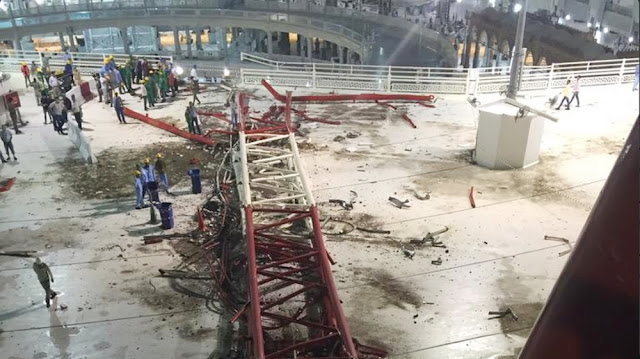Saudi crane collapse kills 107 in Mecca Grand Mosque
Accident which also injured more than 230 people, just weeks before Hajj pilgrimage, blamed on violent thunderstorms.
At least 107 people have been killed after a crane toppled over at Mecca's Grand Mosque, less than two weeks before Islam's annual Hajj pilgrimage.
In addition to the deaths, 238 people were wounded in Friday's disaster, according to Saudi Arabia's Civil Defence Authority.
The Saudi Press Agency quoted a spokesperson for the two holy mosques as saying that the crane was brought down by strong wind and heavy rain.
Pictures circulating on social media showed pilgrims in bloodied robes and debris from a part of the crane that appeared to have crashed through a ceiling.
Other pictures showed queues of Saudi men volunteering to donate blood for the injured.
"All those who were wounded and the dead have been taken to hospital. There are no casualties left at the location," General Suleiman al-Amr, director-general of the Civil Defence Authority, told Al Ikhbariya television.
He said strong wind and rains had uprooted trees and rocked cranes in the area.
"The crane collapsed near Al-Salam gate on the upper side of Al-Masaa area, and that caused the collapse of a small part of Al-Masaa and another section of Al-Mataf, the bridge area around the holy Kaaba," Amr told Saudi state TV.
Official statement
A statement by a spokesperson for the administration of the mosques in Mecca and Medina said the crane toppled in the part of the Grand Mosque where worshippers circle the Kaaba - the black-clad cube towards which the world's 1.6 billion Muslims face to pray.
Al Jazeera's Hasan Patel, reporting from Mecca, said witnesses told him that the crane fell on the third floor of the Grand Mosque at around 5.30pm on Friday.
 |
| In addition to the fatalities, 238 people were wounded in Friday's crane accident in the Grand Mosque, Saudi officials said |
He said the mosque was packed even though the incident happened before the 6.30pm prayer.
"Dozens of ambulances headed to the site. The authorities closed off the area shortly afterwards," he said.
"This whole place is already a giant construction site. What made it worse is that around 5.30pm there was severe rain and it was just gushing down the road.
"I am surrounded by people who are grieving. The mood here is of sadness."
Saudi authorities go to great lengths to prepare for the millions of Muslims who converge on Mecca to perform the sacred pilgrimage.
Last year, they reduced the numbers permitted to make the Hajj pilgrimage on safety grounds because of
construction work to enlarge the Grand Mosque.
construction work to enlarge the Grand Mosque.
Prone to disasters
The Hajj, one of the largest religious gatherings in the world, has been prone to disasters in the past, mainly from stampedes as pilgrims rush to complete rituals and return home.
Hundreds of pilgrims died in such a crush in 2006.
Saudi authorities have since spent vast sums to expand the main Hajj sites and improve Mecca's transport system, in an effort to prevent more disasters.
Security services often ring Islam's sacred city with checkpoints and other measures to prevent people arriving for the pilgrimage without authorisation.
Those procedures, aimed at reducing crowd pressure which can lead to stampedes, fires and other hazards, have been intensified in recent years as security threats grow throughout the Middle East.
Richard Angwin, Al Jazeera's senior weather presenter, said the autumn period is when half of Mecca's thunderstorms occur, so "it was no great surprise that there were thunderstorms in the area".
"The area of low pressure which brought sandstorms across the Levant region moved further south, allowing hot, moist air to develop into thunderstorms along the mountains bordering the Red Sea, and some of those drifted northwards across Mecca," he said.
 |
| Source:Â Al Jazeera and agencies |


إرسال تعليق
Thanks For Your Feed Back